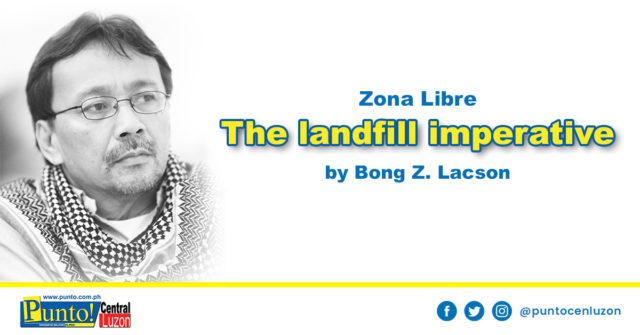LAST WEEK’S closure of four open dumpsites in Pampanga – two in Porac, one in Bacolor, and another in the City of San Fernando, notwithstanding the adamant protestations of Mayor Edwin Santiago – underscores the gravity and the breadth of waste mismanagement by the local governments.
Over 19 years have passed since the passage of Republic Act (RA) 9003 or the Ecological Solid Waste Management Act of 2000, which Section 17 (h) specifically mandates: “Open dump sites shall not be allowed as final disposal sites. If an open dump site is existing within the city or municipality, the plan shall make provisions for its closure or eventual phase out… As an alternative, sanitary landfill sites shall be developed and operated as a final disposal site for solid and, eventually, residual wastes of a municipality or city or a cluster of municipality and/or cities.”
Alas, to this day, no municipality or city in Pampanga hosts even the faintest semblance of a sanitary landfill.
Nearest to the province is the governmentapproved Kalangitan, Capas landfill operated by the Metro Clark Waste Management Corp. While, arguably, capable of servicing the immediate needs of Pampanga LGUs, it has been made more of an alibi for the failings of the LGUs to efficiently, not to say effectively, manage their mounting garbage problems issues.
Aye, that the heaps of stinking unsorted garbage found at what the LGUs said were “transfer stations” were awaiting the MCWC trucks for transport to Kalangitan – an alibi that DENR Usec Benny Antiporda did not buy, promptly closing down the dumpsites.
Weak as it is, it is not enough for the national government – the DENR and the DILG, principally – to institute draconian measures against LGUs found utterly wanting in their compliance with RA 9003.
The imperative of Pampanga having its own sanitary landfill – more advanced and multiphased than that in Kalangitan – has assumed critical proportions, to say the least.
Comes anew the promise of that waste-toenergy sanitary landfill planned in Floridablanca town.
Bukit Tagar
A 100-hectare property in Barangay Pabanlag stands as site for a replicate of Malaysia’s premiere sanitary landfill, the Bukit Tagar Sanitary Landfill (BTSL) and Waste-to- Energy Plant in operation since April 2005 from its location in Selangor state.
BTSL prides itself as a “state-of-the-art model facility for a long-term solid waste treatment serving the capital city of Kuala Lumpur” – a claim grounded on solid backing by the giant conglomerate Berjaya Corp. Berhad which interests run the gamut of property development and investments, hotels and resorts, and consumer marketing.
The BTSL facility is sited in a “landfill footprint” of 283 hectares, surrounded by a plantation buff er zone comprising 404 hectares. Its operational life span is set for 100 years at 3,000 tons of waste per day, based on a population of about 3 million, with a total landfill cell capacity of 120 million tons.
The first thing that one notices upon coming to the place is the absence of the characteristic stench of landfills, and flies. This is effected by the use of “open minimal active cell” in the landfill where rubbish is dumped, leveled and covered with earth daily.
Excavated ground is used as filling even as different liners are used as a substitute for good clay materials at least two feet thick as a third layer of protection.
The landfill is lined with a high-density polyethylene, with the leachate instead of seeping through the aquifer directed at collection pipes that lead to a treatment plant. The leachate undergoes physical, biological, and chemical treatment before it is discharged into an open pond for irrigation of crops. With a capacity of 2,000 cubic meters a day, BTSL’s leachate treatment plant is one of the largest in Asia.
The landfill has a completely separate storm water and surface water drainage system.
Energy
With landfill gas pipes, BTSL has its own engine facility that produces methane gas generating 6.5 mega-watts of electricity daily, part of which is sold to the national grid in Malaysia as mandated by a Renewable Energy Power Purchase Agreement that Berjaya signed with the government.
One of the closed landfill cells has 42 interconnected wells embedded 25 to 60 meters leading to the waste energy plant.
Next in the BTSL agenda for sustainable and environmentally friendly solution to the garbage problem is the establishment of a solar farm.
So, did I read this in some brochure or the BTSL homepage in the web? Absolutely not.
In April 2018, I came a skeptic at the BTSL facility, probed the place, and left a believer. If it be but 80 percent of itself in Floridablanca, Pampanga’s garbage woes would melt in electric joy.





